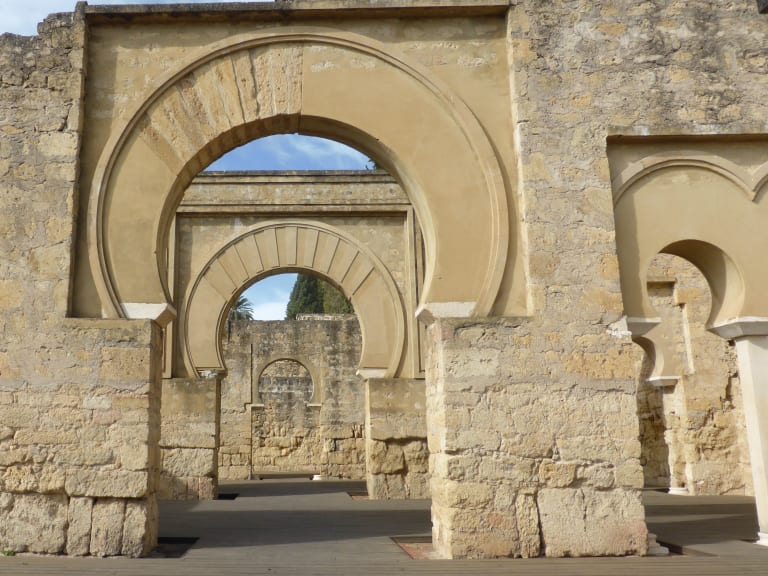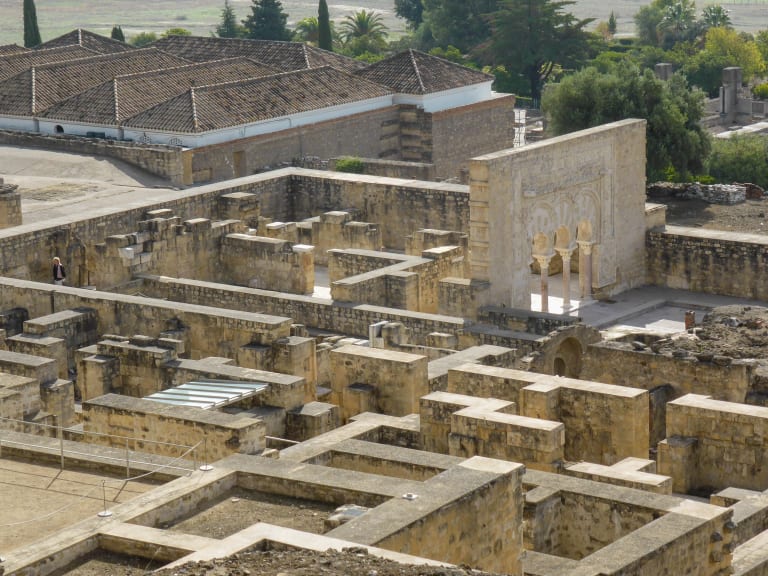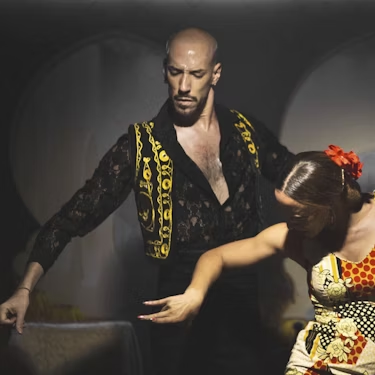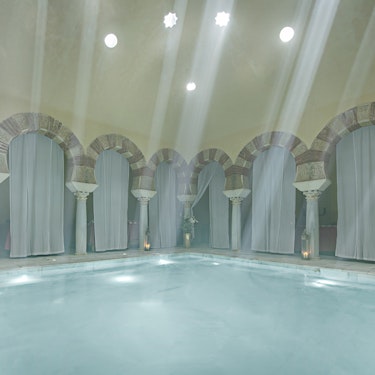More about: Day Trips to Medina Azahara from Cordoba
Cordoba is one of Spain's most exciting cities thanks to its impressive cultural heritage and fascinating history. The period of greatest splendour of Al-Andalus was the Umayyad Caliphate and as a symbol of that greatness a new city called Medina Azahara was erected on the outskirts of Cordoba, the most beautiful city in the Islamic West, which only survived for 70 years.
Today, you can visit its remains just 8 kilometres from Cordoba and thus reconstruct in memory what was once the glory of Medina Azahara. For me it is, without a doubt, one of the essential excursions to do in Cordoba during your holidays. I'll tell you why!
1. How to visit Medina Azahara?

Although you can visit Medina Azahara on your own, from experience I can tell you that given its vast extension and the large number of spaces that make up this site, my advice is to opt for a guided tour to visit the entire Umayyad palatine city without missing any detail. Moreover, with a guide you will learn to decipher its profuse decoration and soak up its history, which is not as well known as that of the Alhambra in Granada.
- Three-hour guided tour of Medina Azahara - From AED 112
2. Visit to Medina Azahara from Córdoba

With this 3-hour visit to Medina Azahara from Cordoba you will travel to the heart of the Caliphate of Cordoba, the period of greatest splendour of Al-Andalus, accompanied by a guide who will tell you the fascinating history of the brilliant city of Abderraman III and show you on foot the remains of this interesting archaeological site.
What does this tour consist of?
This tour to Medina Azahara from Cordoba consists of two parts: on the one hand the visit to the archaeological site of Medina Azahara and on the other hand the visit to its Interpretation Centre.
The tour starts at 10:15 AM at the Cruz Roja roundabout, where you will take the bus to the Medina Azahara complex. Your guide will be waiting for you there, who you can identify by his orange umbrella. Once you indicate the name of your reservation, you will join the group and board another bus to the ruins of the palatine city, which is located 2 kilometres from the Interpretation Centre.
In Medina Azahara you will spend 2 hours with the guide walking among the remains of palaces, ceremonial halls, mosques and workshops learning all the stories and surprising anecdotes about this archaeological site declared World Heritage Site by UNESCO in 2018.
At the end you will return to the Interpretation Centre of the site to start the second part of this excursion to Medina Azahara, which includes a visit to the museum with the guide who will explain all the collections it houses and give you a more complete view of the activity. You will learn a lot!
You will finally arrive in Cordoba around 13:30 PM, a great time to have lunch and continue your holiday in the Andalusian city.
Languages
The activity is available in Spanish and English.
How many travellers per group?
There will be a maximum of 15 travellers in this activity.
Included services
Local guide
3. Guided tour to Medina Azahara

With this 3-hour guided tour of Medina Azahara you will explore in the company of an official guide this incredible archaeological site located just 8 kilometres from Cordoba. A place that bears witness to the greatness of Cordoba in the 10th century during the Umayyad Caliphate.
How does the visit take place?
This guided tour of Medina Azahara starts at 10:30 AM, when at the starting point the group boards the bus to the site from Cordoba.
Once there you will have to take a shuttle bus, which is included in the tour, to go to the ruins of Medina Azahara as they are far from the Interpretation Centre where the first bus will drop you off. With this tour, the entrance to the archaeological site is free for EU citizens while non-EU visitors will have a symbolic price of only 1.50 euros.
The tourof Medina Azahara will then begin with your guide, who will show you the remains of the palaces, gardens, mosques and ceremonial halls of what was the most beautiful city of the Islamic West in the Middle Ages.
During the visit the guide will also tell you some legends and curiosities about Medina Azahara, which in my opinion makes this tour much more fun and entertaining.
Languages
The activity is available in Spanish and English.
How many people per group?
There will be a maximum of 50 travellers in this activity.
Services included
- Shuttle bus from the car park to the site of Medina Azhara
- Official guide
- Free entrance for EU citizens
4. In general, how long does it take to see Medina Azahara?

The duration of the entire visit is approximately 2.5 to 3 hours.
5. Is it possible to visit Medina Azahara on your own?

If you choose to do this excursion at your own pace, in order to better understand the importance of Medina Azahara in the history of Spain, I recommend that you first visit the Interpretation Centre located near the archaeological ruins and then the palatine city, to get a better idea of what it was and meant in Al-Andalus before contemplating its remains in person.
In order to organise your trip to Medina Azahara on your own, I recommend that you download two maps with the itineraries to the museum and the archaeological site that you can find on the official website, which will surely help you to plan your visit!
6. How to get to Medina Azahara?

By bus
A tourist bus leaves from Avenida del Alcázar to the Medina Azahara Interpretation Centre. To get a ticket for this bus you must book a place at the tourist office in Cordoba at least one day in advance.
By car
From the centre of Córdoba you can reach the Medina Azahara Interpretation Centre by taking the A-431 road from Palma del Río until you reach the sign for Madinat al-Zahra.
Once you arrive at the site, park your car in the museum car park and take the shuttle bus up to the archaeological site, which is located two kilometres from the centre. It leaves every 20 minutes and the bus ticket is purchased at the museum.
How to get to the archaeological site?
As I said, the archaeological site of Medina Azahara is located 2 kilometres from the Interpretation Centre, so there is a shuttle bus to connect the two points, which you can take after getting your ticket and registering at the museum.
This bus runs continuously during the opening hours of the centre and passes every 15 to 20 minutes. The ticket costs 2.50 euros (general fare) and 1.50 euros (reduced fare for senior citizens and children aged 5 to 12) and includes a return trip. Children under the age of 5 are free.
The last shuttle bus to take visitors to the ruins of Medina Azahara leaves the car park of the Interpretation Centre 60 minutes before closing time.
Remember that this is the only way to get there, as private vehicles are not allowed to enter the ancient palatine city.
7. Timetable and entrance fee to Medina Azahara

Timetables
Medina Azahara is open from Tuesday to Saturday from 9 AM to 6 PM. Sundays, public holidays and Monday eve of public holidays open from 9 AM to 3 PM. Mondays closed. Also closed on January 1st, January 6th, May 1st, December 24th, December 25th and December 31st.
Depending on the month and the season, opening hours change and night visits to the site of Medina Azahara only are available from 7 PM to 12 AM. For more information, please consult the official website.
Entrance fee
- Free for accredited citizens of the European Union.
- Admission for citizens of other countries is 1.50 euros.
8. Why visit Medina Azahara?

The Alhambra in Granada is the Andalusian palatine city that is the centre of attention and is known the world over for its breathtaking beauty and excellent state of preservation. It receives millions of visitors every year, people queue endlessly at the ticket offices to gain access and tickets are sold out months in advance.
However, not many travellers are aware of the existence of Medina Azahara, the predecessor of the Alhambra as far as Andalusian palatine cities are concerned.
This is because the fate of the two palace complexes was very different. While the Alhambra was able to survive after the end of the Reconquest, the life of Medina Azahara was very short-lived, as it was razed to the ground during the civil war that ended the Umayyad Caliphate and gave way to the Taifa kingdoms. Abandonment, the passage of time and despoilment did the rest.
However, thanks to the restoration work that has been done in Medina Azahara, it is possible to get an idea of the extraordinary beauty that this caliphate city had in its origins and for those of us who are passionate about history and art, it is a marvel to be able to walk around the site imagining what Medina Azahara was like during its period of splendour and the great importance it had in the Middle Ages on a political, cultural and commercial level.
9. What is Medina Azahara like?

I remember that walking through the ruins of Medina Azahara was like taking a trip back in time to the heyday of Al-Andalus and the Umayyad dynasty in Spain - a thrilling experience!
I found it fascinating to have the opportunity to walk through the oldest Andalusian palatine city in the country. The pearl of one of the great empires in the Mediterranean comparable to the Byzantine in its time, for the construction of which architects came from Baghdad and Constantinople.
A visit to Medina Azahara is an adventure in itself. As it is not possible to enter the site by car, you must park your car in the car park of the Interpretation Centre, register and get your ticket here before taking the shuttle bus to the monumental complex.
Although very tempting, it is not possible to get to Medina Azahara by walking through the countryside enjoying the scenery because the road becomes narrow and dangerous in some sections.
Once registered, I boarded the bus that connects the museum with the site (it runs every 15 or 20 minutes) and soon arrived at Medina Azahara.
What to see in Medina Azahara?
The first thing that struck me was the privileged location of Medina Azahara.
Taking advantage of the natural unevenness of the land, the city was planned in a system of terraces on three levels, so that in the upper area the Alcázar Real ( the caliph's residence from where he could contemplate the valley of the Guadalquivir) was built, the middle part was dedicated to the administration buildings and the homes of the court officials and the lower area was the medina proper.
Although the city was razed to the ground by war and later by despoilment, I was surprised that there are still traces of the opulence of the decoration that this palatine city once boasted.
The decoration of the palatine city
Caliph Abderraman III spared nothing, for Medina Azahara represented the power of his newly proclaimed caliphate, and so everything was designed to show the world the splendour of the Umayyad dynasty.
White marble was brought from Portugal for the columns and capitals, alabaster was used for the floors of the most important rooms and local purplish limestone provided an exquisite contrast between the red decorations and the white walls.
Add to this the profuse decoration with plant motifs, epigraphic inscriptions, gardens, fountains and ponds, and it is easy to understand why Medina Azahara was said to be one of the most splendid cities ever built by man.
What are its most outstanding spaces?
Here you can see the Caliph's Royal House and the magnificent Rico Hall, where political receptions were held in the city and which was characterised by its rich decoration. Also the Aljama Mosque and the house of Ja'far, the residence of the first minister of the Caliph Alhaken II, who built the maqsura of the mosque of Cordoba.
Other areas of interest are the great Portico, the eastern entrance to the Alcazar area, and the house of the Alberca, which is believed to have been the residence of Caliph Al-Haken II.
What is the Interpretation Centre like?
The aim of this museum is to promote the study and dissemination of the archaeological site of Medina Azahara and to act as a bridge between the Western and Eastern worlds.
The tour consists of a 60-minute introduction to Medina Azahara that will allow you to discover its history through four permanent exhibitions that deal with the following topics:
- The foundation of the city and its context.
- The construction of Madinat al-Zahra.
- The city and its inhabitants.
- The destruction and recovery of Madinat al-Zahra.
All the historical objects found in the archaeological excavations are kept here, and a 15-minute audiovisual documentary called "Madinat al-Zahra: the shining city" is shown, which is worth watching to learn more about Medina Azahara and life there, as it was inhabited by more than 20,000 people at the time.
10. How was Medina Azahara born?

Legend has it that Abderramán III, the first Caliph of Córdoba, ordered the construction of the palatine city of Medina Azahara at the foot of the Sierra Morena mountains in the 9th century to please the whim of Azahara, his favourite concubine.
However, the real origin of this palace complex lies not in the romanticism of the ruler but in a purely political reason.
On the one hand, the caliph wanted to consolidate his image of power after the establishment of the independent Caliphate of Córdoba and to advertise his power, wealth and good taste to his adversary kingdoms. On the other hand, Abderraman III also wanted to get away from his subjects in a city as populated as Córdoba was at the time and live in an idyllic place separated from the rest of society, in keeping with the medieval mentality of the time.
11. Why did Medina Azahara disappear?

The great work of Abdarrahman III was Medina Azahara, a symbol of the political power of the self-proclaimed caliph of Al-Andalus. The death of his son Alhakam II ushered in the caliphate of his grandson Hisham II, who indulged in worldly pleasures and was a puppet in the hands of his vizier, the famous Almanzor, who eventually became the ruler of Al-Andalus.
Almanzor thus abandoned Medina Azahara and founded Medina Alzahira, his own palatine city to the west of Córdoba, which has not been located to date.
What no one could have suspected was that the days of the Umayyad Caliphate were numbered. It disappeared in 1031 for good, after a fierce civil war that overthrew Hisham III and led to the division of the territory into different kingdoms known as the Taifa kingdoms.
From then on, Medina Azahara was burnt and sacked. It fell into oblivion for centuries, until 1911, when the first archaeological excavations brought to light the remains of the ancient Umayyad palatine city, declared a World Heritage Site in 2018.
12. Tips for visiting Medina Azahara

When to visit Medina Azahara?
Any time of the year is a good time to visit Medina Azahara, although temperatures in summer tend to be quite high. That is why during this season I advise you to visit early in the morning or late in the afternoon.
Is it possible to buy food and drink at the archaeological site?
It is not possible to buy water or food inside, so I recommend carrying a bottle and some dried fruit and nuts in your backpack in case you work up an appetite.
However, the Interpretation Centre has a cafeteria-restaurant where you can recover your energy after the excursion.
How to dress to see Medina Azahara?
There is a lot to see during your visit to Medina Azahara, so you will be walking for quite a while. Remember to wear comfortable clothes and footwear, and to protect yourself from the cold in winter and the sun in summer.
13. How to complete the visit to Medina Azahara?

If you are planning a trip to Cordoba, I recommend you take a trip to Medina Azahara and complete it with a visit to the mosque-cathedral to understand the importance of the Umayyad capital in the 10th century.
In my article Tickets for the Mosque of Cordoba I tell you all the details about how to get tickets to this temple and the different tours available.
If you are travelling to Andalusia in the footsteps of Al-Andalus, another magnificent palatine city you can discover is the Alhambra in Granada.
If you want to include it in your trip, you have several options to explore this marvellous medieval Nasrid fortress. I explain them in detail in my article Tickets and guided tours of the Alhambra in Granada.















